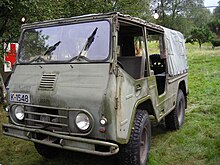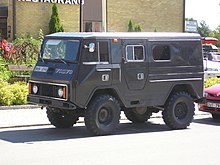Volvo C202
The Volvo C202 is an all-terrain multi-purpose vehicle from the Swedish automaker Volvo , which was built from 1977 to 1981.
technology
Its forerunner was the L3314 (or L3315 as a radio car with 24 V on-board voltage), also known as the Laplander , which was produced in Sweden in the 1960s exclusively for the Swedish military . Because of his cute appearance he was soon called "Valp" (in German "puppy") in Sweden. The later C202 looked very similar to the L3314 / 5, the layman mainly noticed the changed door handles, indicators and taillights as well as the raised side bolsters of the C202 as differences to the L3314 / 5. They differ widely in terms of interior fittings and, above all, technology. At the request of the Swedish military, the L3314 / 5 was followed by its successor in the 1970s, the so-called C30x series with the (civil) designations C303, C304 and C306. However, this series was much larger, heavier and more expensive than the first Laplander series L3314 / 5. For this reason, a manageable commercial and municipal customer target group (electricity network operators such as Vattenfall, rescue services, mountain rescue services, technical relief organizations, etc.) wanted a more adequate successor to the L3314 than the C30x series. They needed a small, light, manoeuvrable, and inexpensive general-purpose transport vehicle. In order to meet this customer demand and market, Volvo had the C202 manufactured by Hungarocamion in Hungary from 1977–1981 in 3,222 units. The C202 is therefore the only purely civil Lapland series and - at least in Sweden - has never been used for military purposes. Therefore it was only available with an on-board voltage of 12 volts.
The sheet steel body was designed in two parts: a pickup-like basic body served as the basis for all body variants, followed by a firmly screwed hardtop (the operating instructions call this variant the "fully covered steel body") or in the so-called "covered crew car version" with the "platform version" a tarpaulin roof ("covered driver's cab and open steel platform"). A third variant was the canvas version, a full convertible without doors, which was produced in even smaller numbers and is now almost extinct. Upon request, the cargo area could be ordered with six foldable seats. So you had an eight-seater all-terrain crew transporter only 4.0 meters long.
The B18A engine previously used in the L3314 with a displacement of 1.8 liters and 68 hp (50 kW) was no longer used in the C202; instead, Volvo used its B20A with a displacement of 2.0 liters and 82 hp, which had proven its worth from the 240 series (60 kW). In addition, the more powerful M45 gearbox was adopted from the Volvo 244, which was introduced shortly before . The FD51 transfer case, developed by Volvo itself, was flange-mounted here and distributed the power to the two drive shafts with a claw coupling . In contrast to the L3314, the all-wheel drive was not activated mechanically by lever, but pneumatically with vacuum cylinders supplied by the vacuum in the intake pipe. There was a reduction gear as standard and, on request, a cable winch coupled to it (attached in front of the rear axle) and / or a PTO shaft to drive a wide variety of attachments. This equipment is sought after by collectors nowadays. The maximum speed of the car was specified as 115 km / h, consumption fluctuates between 12 and 13 liters in long-distance operation on the road and up to approx. 30 liters in off-road operation.
Due to the specific target group of customers, Volvo offered the three basic body variants box, pickup and canvas in countless special versions from the beginning, e.g. B. ambulance superstructures, crane trucks, fire trucks etc. Unfortunately (from today's collector's point of view) the majority of these body variants remained with a few colorful, imaginative pictures in the sales brochures of that time, not even prototypes were made by most of the "designer / marketing strategist plans" built. The only special version of the C202 that still exists today in approx. 5 roadworthy copies is the so-called island version. This is the then already rare and almost unsaleable canvas variant (full convertible), which was shipped in 150 units to Reykjavík / Iceland and was converted there by a local company (with a name that has not yet been researched) in individual versions exactly according to customer requirements . The main features of this small series are large, smoky black side windows, a fixed front window (instead in a folding sunroof), the rear that can only be opened without the rear window, and finally the long-awaited wide side door similar to the C30x (instead of the 2 small hatches on both sides of the vehicle in the standard C202) Homely interior design in burgundy velor, the reduction of the bonnet cover that protrudes far into the interior of the rear passengers and the associated relocation of the vehicle battery from the engine compartment to the interior under one of the single stools, and other minor changes. On the European mainland there is only one copy of this version that was imported in 2007.
The entire C202 series was never officially sold by Volvo outside of Scandinavia, so even today many Volvo dealers do not even know of the existence of this vehicle. The few 10 or 20 C202s that came to Germany as new vehicles were imported gray by dealers or private individuals. Nowadays one can most likely still find employees in the German Volvo Truck Centers who have heard of the Volvo Laplander here and there in their (long) professional career or even seen a copy, since the C202 series in Sweden is Truck Center was driven out. However, all of the workshop manuals for the series are also available in German, with the exception of the German user manual, which is required reading for C202 collectors and C202 screwdrivers.
Present stock
In Germany there are fewer than 50 ready-to-drive Volvo C202s. The prices range between € 5,000 (in need of restoration) and € 10,000 (good roadworthy condition, body usually with rust damage) up to € 20,000 (fully restored vehicles without rust).
The engine parts that are identical to those of the Volvo 240 passenger car series can be easily obtained as replacements, the Lapland-specific parts (axles, gearboxes, lighting, fittings, etc.), on the other hand, are poor, the last new parts are even from the Volvo central warehouses in disappeared in the Netherlands and Sweden and collectors and enthusiasts have to be satisfied with used parts or new products from small Swedish manufacturers.
Literature on the C202 (and its predecessor L3314 / 5)
- Book "Cross-Country Cars from 1945", published in 1975 by Warne-Verlag, type cross-section Volvo off-road vehicle on 2 pages, but only models before 1975, so without C202, in English
- Off-road vehicle manual 1979 (Berner Verlag), short presentation with techn. Data C202 + C303 + C306 (German)
- Overlander 6/1979, world travel report Volvo C202 from Europe to Australia "A quick trip through the world's trouble spots" (English)
- Automobil + Motorrad Chronik 2/1983, type cross section (German)
- Volvo Club News 2/1989, Type cross section (German)
- 4WheelDrive 5/1991, Valp L3314 from Altyco with 44 ″ wheels (Swedish)
- Offroad Magazin 3/1993, type cross section (German)
- Offroad Magazin special edition "4x4 oldtimer and used cars" 2/1994, type cross section (German), same report as in Offroad 3/1993, but 4 more pictures (p. 71 + 73)
- Offroad Magazin 1/1999, type cross-section with focus on open anti-tank gun carriers 9031 (German)
- Printed and bound documentation by Stefan Keller, 10/2003: Volvo - Background on the construction of off-road vehicles up to 1981, type cross section (German)
- Offroad Magazin special edition Pick-Up / Camper / Expeditionsmobile 3/2004: "With the Laplander to Iceland", restoration and travel report C202 (German)
- Oldtimer Praxis 3/2005, restoration report C202 (German)
- Swiss Classics Revue No. 17, 1/2008, Report L3314 (German)
- Offroad 6/2012, vacation travel report "Petersens Nordfahrt", Sweden trip with the C202 (German)
Original manufacturer literature from Volvo on the C202
- Service manual for C202 (complete workshop instructions), 17 books, divided into Dept. 0–9 (German)
- Volvo C202 Sales Brochure 1978 (English)
- Volvo C202 Vehicle Options Specification Sheets 1978 (English)
- Tire approval for C202 from Volvo Trucks (Deutschland) GmbH, Sales Engineering, Dietzenbach, October 15, 2002 (German)
- Instruction book C202 (Swedish) or operating instructions C202 (German)
Similar vehicles
Trivia
A C202 / Laplander plays the "main role" in the novel Liebe Isländer by Huldar Breiðfjörð (1998).
Web links
- zztosh.de: Technical information and images (accessed March 9, 2013)
- Autobild.de: A driving report with photos (accessed March 9, 2013)
- 4wheelfun.de: A travel report with the C202 (accessed March 9, 2013)








